Elevate Your Salesforce Game: The Top 5 DevOps Tools
Master the art of Salesforce DevOps with our in-depth exploration of the top 5 essential tools. Learn how automation, version control, and collaboration can supercharge your development process and drive business success

DevOps tools play a vital role in streamlining the Salesforce development process. These tools facilitate seamless collaboration between development and operations teams and enhance efficiency throughout the development lifecycle. In today's rapidly evolving technological landscape, where organizations strive for an agile and continuous delivery of high-quality software solutions, the significance of using DevOps tools in Salesforce development cannot be overstated.
The key benefit of leveraging these tools lies in fostering collaboration between development and operations teams. DevOps tools enable developers and operations personnel to work closely together, align their efforts, and resolve any conflicts that may arise during the development process by providing a common platform for communication and information sharing.
Moreover, DevOps tools offer a range of features designed to boost efficiency in Salesforce development. These features include version control systems, continuous integration and delivery frameworks, automated testing, and deployment tools. These capabilities ensure the development process runs smoothly, with minimal disruptions and time wasted on repetitive manual tasks.
Top 5 Salesforce DevOps Tools
Salesforce DevOps Tools are essential for organizations to streamline their development and deployment processes on the Salesforce platform. These tools help teams collaborate effectively, automate tasks, and ensure the smooth delivery of high-quality applications.
In this article, we will explore the top five Salesforce DevOps tools that professionals in the industry widely use. From version control to continuous integration and testing, these tools offer an array of functionalities that can enhance the overall development lifecycle of Salesforce applications.
Whether you are a developer, administrator, or project manager, incorporating these tools into your Salesforce DevOps strategy can vastly improve your efficiency and productivity. Let's dive into the details of these top Salesforce DevOps tools and discover how they can revolutionize your development process.
1. Copado
Copado is a Salesforce-native application that provides advanced DevOps capabilities for Salesforce development teams. Its architecture is built on top of Salesforce, utilizing its robust platform and infrastructure. Copado seamlessly interacts with Heroku, a cloud application platform, through the Copado API.
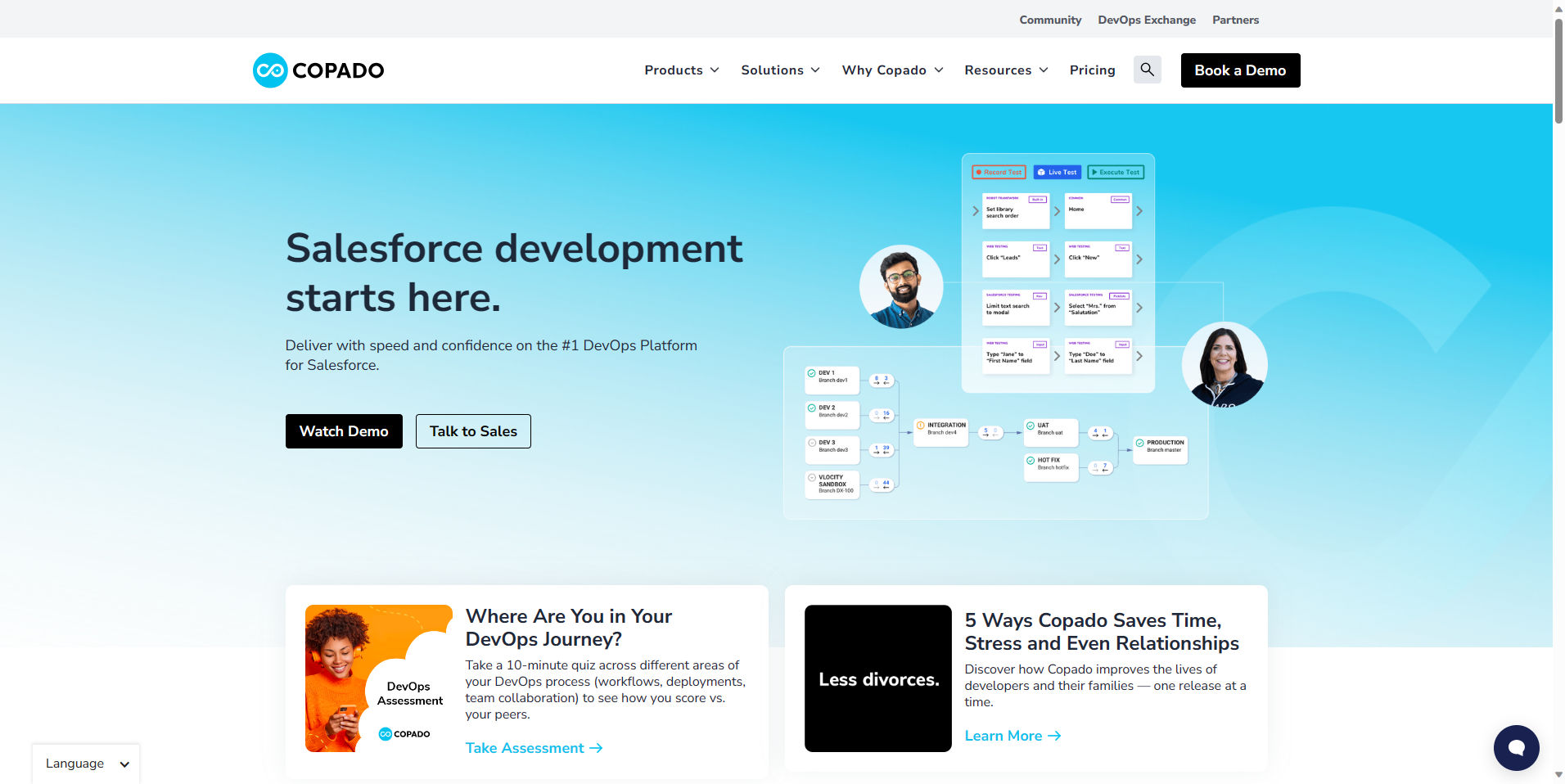
At the core of Copado's architecture is its integration with Salesforce, allowing development teams to leverage the power of the Salesforce platform. This Salesforce-native nature ensures that Copado aligns with Salesforce's best practices and supports its functionalities.
Copado also integrates with Git, a popular version control system, enabling teams to manage their source code and track changes easily. This integration allows for smooth collaboration between developers and enhances the overall development process.
Regarding application lifecycle management, Copado provides a comprehensive set of features. It enables teams to plan, develop, test, and deploy applications effectively and efficiently. With its integration with Heroku, Copado facilitates seamless deployment of Salesforce applications to the Heroku platform.
Key Features
1. Continuous Integration and Continuous Deployment (CI/CD): Copado offers a robust CI/CD platform that enables organizations to deliver high-quality Salesforce applications quickly. It automates the entire application delivery process, including building, testing, and deploying, ensuring frequent and reliable releases. The CI/CD pipeline helps teams collaborate effectively, reduce development cycles, and minimize deployment errors. With Copado's CI/CD capabilities, businesses can achieve a sustainable DevOps model, improving efficiency and customer satisfaction.
2. Release Management: Copado provides powerful release management capabilities that empower organizations to efficiently plan, coordinate, and track their Salesforce releases. It offers a comprehensive release calendar that visualizes all releases across different environments, making it easier to manage complex release processes. Copado enables teams to create user stories, organize them into sprints, and monitor their progress, providing complete visibility into the release lifecycle. It also facilitates end-to-end governance, compliance, and approval workflows, ensuring that every release meets the organization's quality standards.
3. Collaboration and Visibility: Copado promotes seamless collaboration and transparency among development teams, stakeholders, and business units. It offers a centralized platform where all team members can collaborate, assign tasks, share knowledge, and provide feedback. Copado's real-time dashboards provide valuable insights into deployments, test results, and team performance, enabling stakeholders to make informed decisions. It also integrates with popular communication and project management tools, such as Slack and Jira, enhancing cross-functional collaboration. With Copado, organizations can break down silos, foster teamwork, and promote a culture of excellence.
Pricing
- Express Edition: $1000 / Month
- Copado 1 Edition: Contact sales
| Pros | Cons |
|---|---|
|
|
2. Hutte
Hutte in Salesforce DevOps is a powerful tool with several key features and benefits. First and foremost, it has an intuitive user interface (UI) that makes it easy to navigate and use, even for users with minimal technical expertise. This ensures a smooth experience for developers and administrators, streamlining their workflows and increasing productivity.
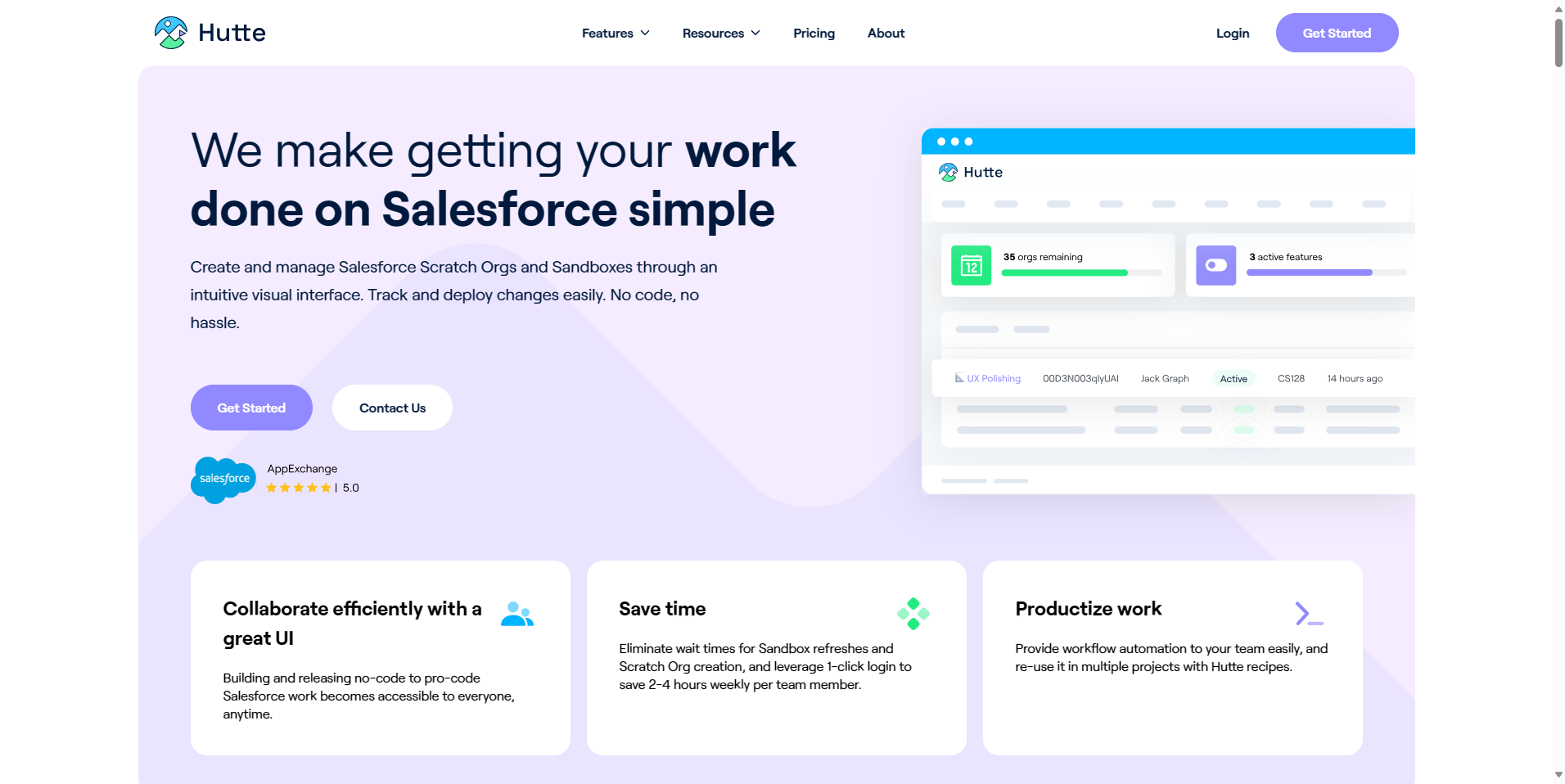
One standout feature of Hutte is its scratch org and sandbox management capabilities. It allows users to effortlessly create, manage, and delete scratch orgs and sandboxes, providing a secure and isolated environment for development and testing. This helps avoid conflicts and minimizes the risk of errors when working with multiple developers or teams.
Another significant advantage of Hutte is its seamless integration with Salesforce. It seamlessly connects with Salesforce, enabling users to deploy and manage metadata and code changes directly from the platform. This eliminates the need for manual, time-consuming processes and reduces potential errors.
Hutte also simplifies metadata field creation by offering a user-friendly interface. It lets users quickly define and customize metadata fields, making managing data and handling complex configurations more efficient.
Additionally, Hutte provides automated scripts that automate various processes, such as deploying changes, running tests, and generating reports. This automation saves time and effort, allowing developers to focus on more critical tasks.
Key Features
1. User-friendly interface: Hutte provides an intuitive visual interface allowing you to create and manage Salesforce Scratch Orgs and Sandboxes easily. The interface is designed to be simple and easy to use, making it accessible to everyone, regardless of their technical expertise.
2. Git-based development: Hutte embraces Git-based development, which is a structured way to track, manage, and collaborate on code. With Hutte, you can preview and commit changes through an intuitive UI and leverage automated workflows. This approach streamlines the development process, ensuring projects evolve seamlessly and efficiently.
3. Workflow automation: Hutte efficiently automates your team's workflow and reuses it in multiple projects with Hutte recipes. With Hutte, you can eliminate wait times and redundant tasks and focus on what truly matters. Hutte enables you to manage environments, track and integrate changes, and deploy anywhere.
Pricing
- Free Plan: $0 / Month
- Organization Plan: $25 / Month
- Enterprise Plan: Contact Sales
| Pros | Cons |
|---|---|
|
|
3. Gearset
Gearset is a powerful tool that simplifies and enhances the management of Salesforce releases. By providing a user-friendly interface and visualizing Salesforce metadata, Gearset streamlines the process of deploying changes and ensures a seamless release cycle.
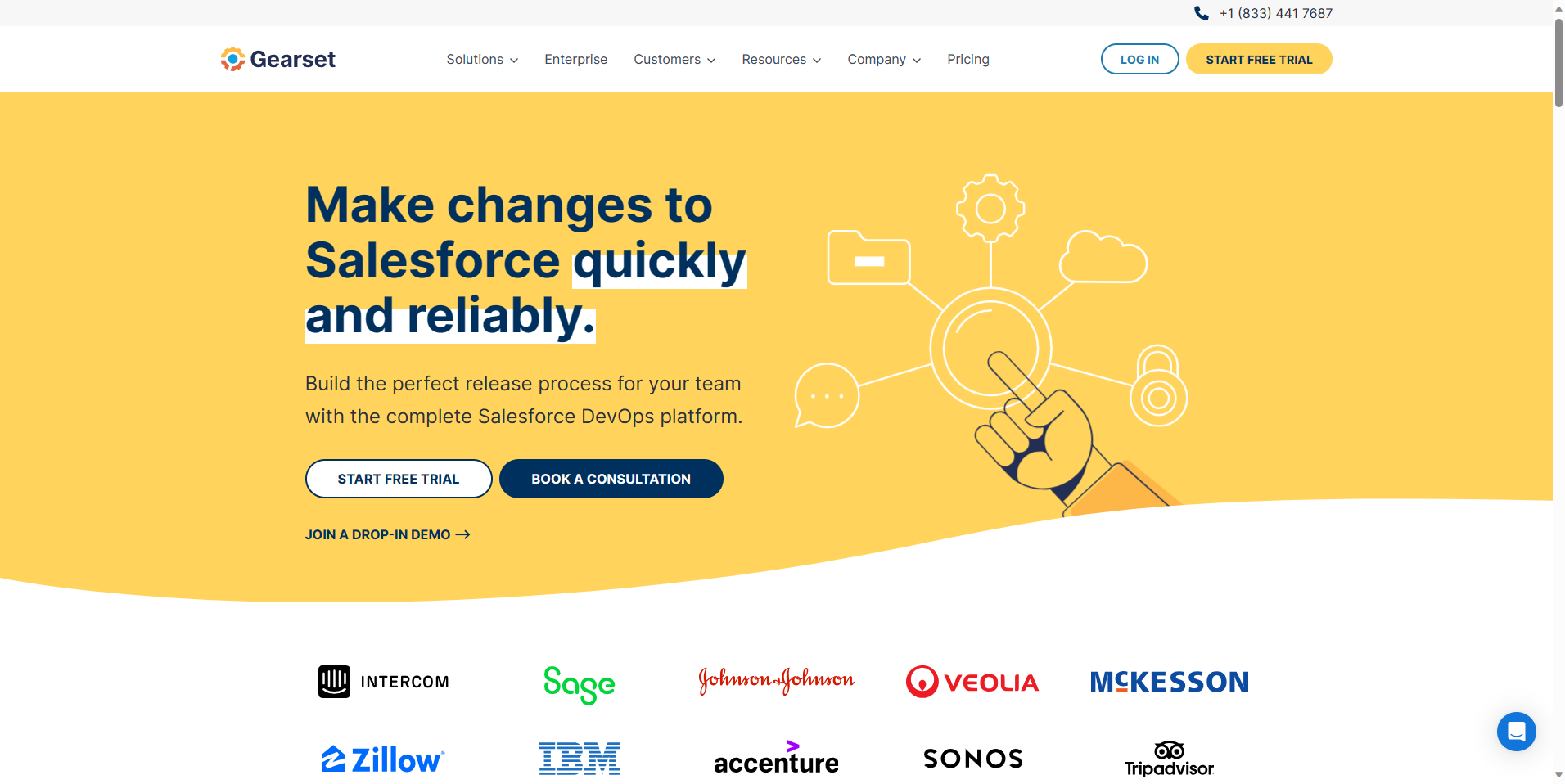
`One of the key features of Gearset is its version control capability. It allows teams to track and manage changes to their Salesforce org, providing a comprehensive history and documentation of all modifications. This ensures transparency, facilitates collaboration, and makes it easier to roll back to a previous state if necessary.
In addition, Gearset offers continuous integration, enabling developers to automate the process of building, testing, and deploying changes. By automatically detecting any conflicts or issues, Gearset reduces errors and ensures that changes are adequately tested before being pushed to production.
Automated testing is another crucial feature of Gearset. It allows teams to easily create and execute tests to validate the functionality and stability of their Salesforce org. This saves time and improves the overall quality of the releases.
Gearset also provides rollback functionality, which can be a lifesaver in case of any issues or unexpected consequences. With just a few clicks, teams can revert to a previous version to quickly resolve any problems arising during the release.
Overall, companies use Gearset for its user-friendly interface, powerful features, and visualization of Salesforce metadata. It enhances collaboration, ensures version control, automates testing, and provides an easy way to roll back changes. With Gearset, Salesforce release management becomes a seamless and efficient process.
Key Features
1. Simplified Deployment Process: Gearset offers a streamlined deployment process, making it easier and faster for developers to release changes to production. With its intuitive user interface, developers can easily select the components they want to deploy, such as metadata, code, and data, and deploy them in a few simple steps. Gearset also visually represents changes between different orgs, allowing developers to track and manage their deployments easily.
2. Version Control and Collaboration: Another key feature of Gearset is its robust version control capabilities. It seamlessly integrates with popular version control systems like Git, allowing developers to track and manage changes to their Salesforce orgs. This feature also enables collaboration among team members, as they can work on different branches and easily merge their changes. Gearset also provides a detailed audit trail, ensuring transparency and accountability during development.
3. Continuous Integration and Testing: Gearset supports continuous integration and testing, enabling developers to automate their release processes. It integrates with popular CI/CD tools like Jenkins and Azure DevOps, allowing developers to automatically build, test, and deploy their changes. Gearset also offers comprehensive testing capabilities, including regression testing, code coverage analysis, and performance testing. This helps developers ensure the quality and stability of their releases, reducing the risk of introducing bugs and issues into their Salesforce orgs.
Pricing
- Starter: $200 / Month
- Teams: $300 / Month
- Enterprise: Contact sales
| Pros | Cons |
|---|---|
|
|
4. AutoRABIT
AutoRABIT is a comprehensive DevOps platform designed for Salesforce and other cloud-native applications. The key features and architecture of AutoRABIT provide a seamless and efficient solution for Salesforce deployments and release management.
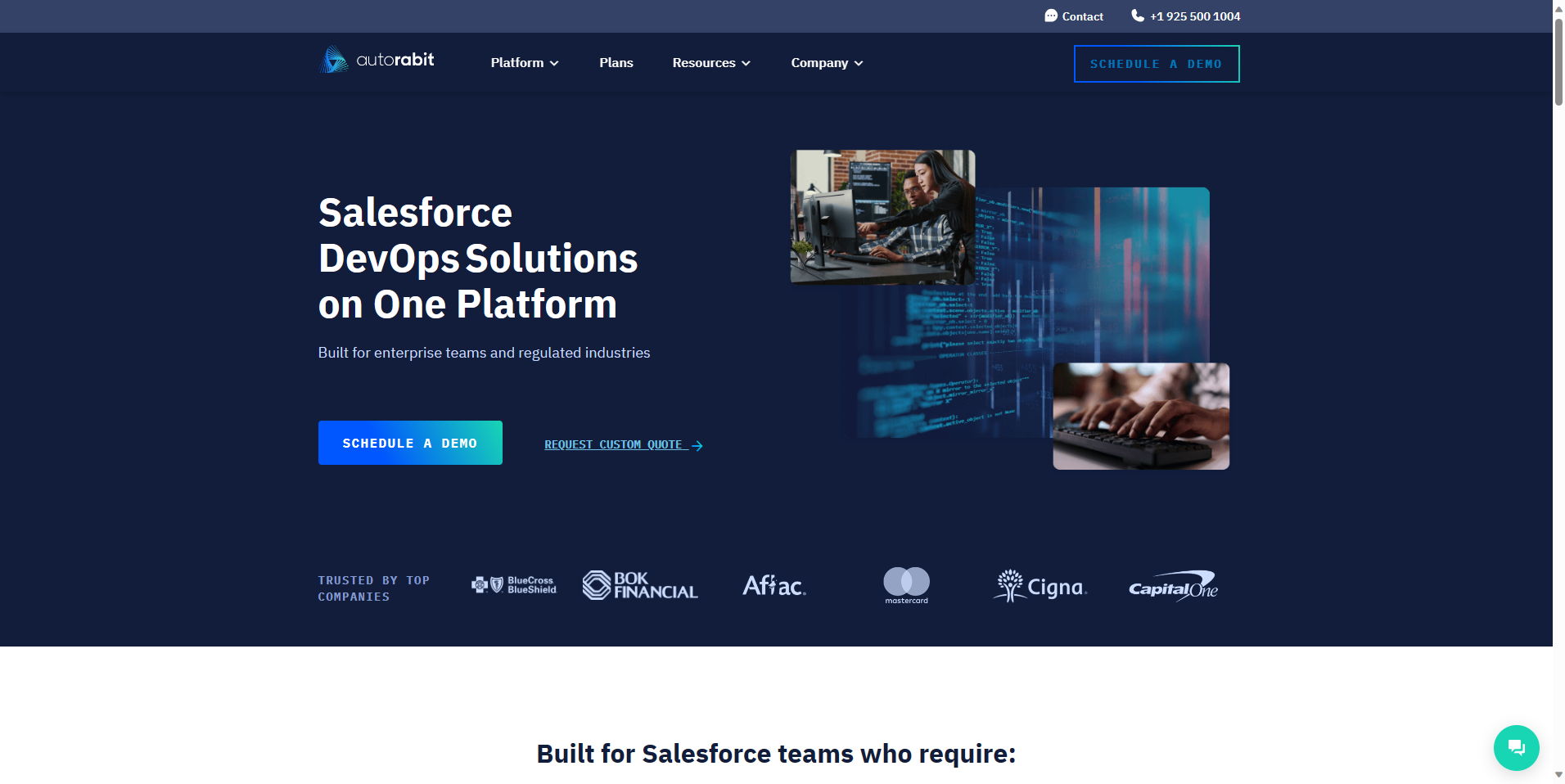
AutoRABIT aims to automate and streamline Salesforce development and release processes, enabling organizations to achieve continuous integration and delivery. It offers a suite of tools encompassing the entire software development lifecycle, including version control, automated testing, build automation, and deployment automation.
AutoRABIT has partnered with leading organizations in the Salesforce ecosystem, such as Salesforce, Amazon Web Services, and Microsoft Azure, to provide a robust and integrated solution. These partnerships enable users to leverage the Salesforce platform's and cloud infrastructure's full potential.
One of the key features of AutoRABIT is its environment management capabilities. It allows users to easily manage multiple Salesforce environments, such as development, testing, and production, ensuring consistency and scalability across deployments.
AutoRABIT enhanced its functionality by acquiring CodeScan, a Salesforce's leading static code analysis tool. This acquisition enables users to identify and address quality issues in their Salesforce code, ensuring clean and efficient deployments.
AutoRABIT offers flexible setup options, including cloud-based and on-premises installations, catering to organizations' specific requirements and preferences.
In terms of integration capabilities, AutoRABIT seamlessly integrates with popular tools and platforms such as Jira, Git, Jenkins, and Selenium, ensuring smooth collaboration and interoperability across different DevOps workflows.
Overall, AutoRABIT's key features and architecture empower organizations to automate and accelerate their Salesforce development processes, leading to increased productivity, improved quality, and faster time to market.
Key Features
1. Continuous Integration and Continuous Deployment (CI/CD): AutoRABIT enables organizations to automate their build, test, and deployment processes through its robust CI/CD capabilities. It allows developers to easily integrate their code, run automated tests, and deploy changes to multiple Salesforce environments. By automating these repetitive tasks, AutoRABIT significantly reduces the risk of manual errors and accelerates the delivery of high-quality Salesforce applications.
2. Version Control and Release Management: AutoRABIT offers seamless integration with popular version control systems like Git and Subversion. It provides organizations a centralized repository to store, manage, and track changes to their Salesforce codebase. AutoRABIT's release management capabilities also empower organizations to efficiently plan, schedule, and deploy Salesforce releases, ensuring smooth and controlled deployments.
3. Sandbox Management and Data Loader: AutoRABIT simplifies the management of Salesforce sandboxes, allowing developers to refresh, clone quickly, and manage sandbox environments. This feature eliminates the complexities and time-consuming manual efforts involved in sandbox management. Moreover, the built-in Salesforce Data Loader in AutoRABIT enables easy and secure data migration and synchronization between sandboxes and production environments, enhancing data integrity and accuracy.
Pricing
- Request a custom quote based on the functionality you need
| Pros | Cons |
|---|---|
|
|
5. Flosum
Flosum is a highly acclaimed DevOps solution that offers many features and advantages to streamline development processes. As one of the highest-rated products on the Salesforce AppExchange, Flosum stands out for its seamless integration with Salesforce and third-party tools.
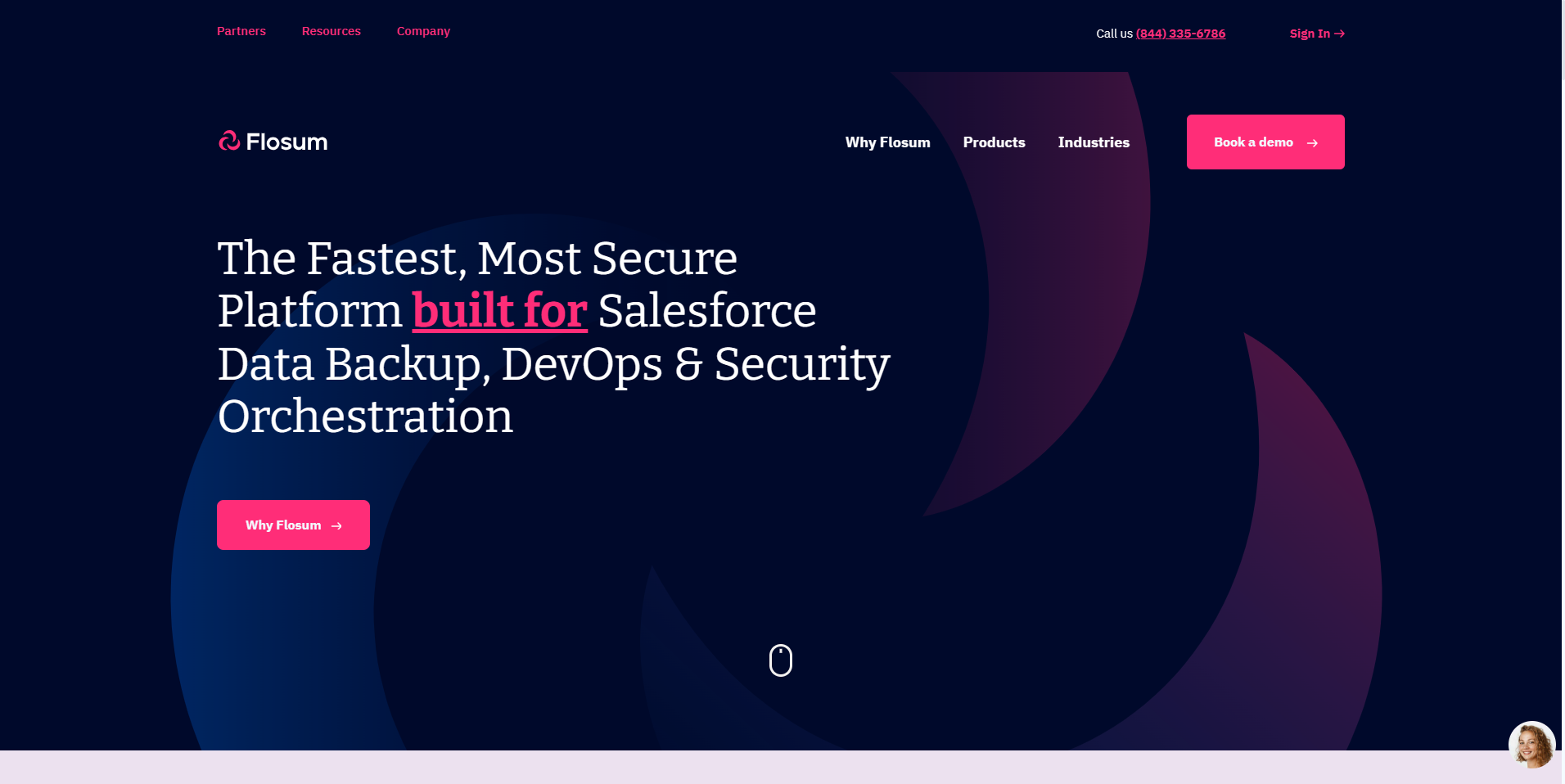
One of the key highlights of Flosum is its advanced impact analysis capabilities. With this feature, teams can assess the potential impact of any changes before deploying them. This helps minimize risks and ensure smooth development cycles.
Another significant advantage of Flosum is its native version control feature. This allows users to effortlessly manage and track changes in their codebase, ensuring complete visibility and control over the development process. Additionally, Flosum enables fast deployments, helping organizations achieve quicker time-to-market for their applications.
By leveraging Flosum's DevOps capabilities, teams can effectively collaborate in real-time, streamline their development processes, and optimize the delivery of high-quality applications. Overall, Flosum offers a comprehensive and integrated solution for managing the entire development lifecycle within the Salesforce ecosystem and beyond.
Key Features
1. Advanced Version Control: Flosum provides a comprehensive version control system that allows developers to manage their source code and track changes seamlessly. It offers a user-friendly interface where users can easily view, compare, and revert to previous code versions. With Flosum's granular version control, developers can confidently experiment, test, and roll back changes without compromising the stability and integrity of their Salesforce org.
2. Agile Release Management: Flosum supports Agile development methodologies with its robust release management capabilities. It enables teams to plan and execute their releases efficiently, ensuring that the right features reach the production environment at the right time. Flosum's release pipelines allow for automated testing, validation, and deployment, reducing manual effort and minimizing the risk of errors. It also offers advanced branching and merging features to facilitate parallel development and accelerate release cycles.
3. Compliance and Governance: Flosum ensures compliance with industry standards and regulatory requirements. It provides comprehensive visibility into the development and deployment process, allowing organizations to enforce and maintain rigorous governance policies. Flosum's fine-grained access controls and audit logs enable organizations to track changes and ensure data integrity. It also offers features like automated code review and compliance checks, preventing vulnerabilities and ensuring code quality.
Pricing
- You will need to contact Flosum to find out specific pricing
| Pros | Cons |
|---|---|
|
|
Choosing A DevOps Tools
When choosing a DevOps tool, several factors must be considered to ensure its suitability for the organization's needs. Firstly, evaluating the tool's compatibility with the existing infrastructure and technology stack is crucial. The tool should seamlessly integrate with the organization's systems to avoid disruptions and minimize the learning curve for the development and operations teams.
Another important consideration is the tool's scalability and flexibility. As the organization grows and its requirements evolve, the DevOps tool should be able to adapt and handle increasing workloads efficiently. It should be capable of automating processes, managing multiple environments, and supporting deploying a wide range of applications.
Furthermore, the tool's ease of use and user-friendly interface are essential for effective adoption and collaboration. The easier teams understand and utilize the tool, the more seamless their workflow will become. Additionally, the tool's documentation, support, and community engagement play a significant role in troubleshooting issues and gaining valuable insights.
Security is another vital factor when selecting a DevOps tool. It should have robust security features to protect sensitive data and prevent unauthorized access. This includes secure storage of credentials, role-based access control, and encryption capabilities.
Lastly, the tool's cost and licensing model should align with the organization's budget and growth strategy. It is essential to evaluate the tool's pricing structure and any additional expenses, such as training or support, to ensure it provides value for money.
Final Word
A culture of open communication, continuous learning, and shared responsibility is crucial for successfully adopting Salesforce DevOps. This culture ensures that all team members are actively engaged, improving collaboration, innovation, and efficiency. Open communication facilitates the exchange of ideas, feedback, and concerns, helping to identify potential issues early on and find practical solutions. It also fosters transparency and trust among team members, which is essential for a smooth DevOps process.
Continuous learning is key in the dynamic world of Salesforce DevOps. By embracing a culture of continuous learning, teams can stay up-to-date with the latest tools, technologies, and best practices. This allows for ongoing improvement and innovation, enabling organizations to effectively adapt to changing market demands and leverage new Salesforce capabilities.
Organizations should promote open communication through regular team meetings, brainstorming sessions, and collaboration tools to integrate these practices into daily operations. Continuous learning can be encouraged through training programs, workshops, and knowledge-sharing sessions. Shared responsibility can be fostered by clearly defining roles and responsibilities, establishing cross-functional teams, and promoting a culture of accountability.
Frequently Asked Questions
What are the top salesforce DevOps tools in the market?
The top salesforce DevOps tools in the market are Salesforce DX, Copado, Gearset, Flosum, and AutoRABIT. These tools offer various features and functionalities to aid in developing, testing, and deploying Salesforce applications.
What is Salesforce DX?
Salesforce DX is a powerful DevOps tool that facilitates the development and deployment of Salesforce applications. It offers source control, continuous integration, and automated deployment, enabling teams to collaborate effectively and efficiently.
How does Copado differ from other Salesforce DevOps tools?
Copado stands out among Salesforce DevOps tools as it is built natively on the Salesforce platform. It integrates seamlessly with Salesforce environments and provides additional features like advanced release management, compliance, and extensive reporting capabilities.
What are the key benefits of using Gearset?
Gearset simplifies the Salesforce release management process by streamlining and automating tasks such as deployment, comparing orgs, and managing metadata. It also offers features like impact analysis, conflict resolution, and rollback capabilities, which enhance overall development productivity.
Is Flosum suitable for enterprises with complex Salesforce deployments?
Yes, Flosum is designed to handle complex Salesforce deployments. It offers an intuitive user interface, agile change management, and advanced version control capabilities. Additionally, Flosum enables organizations to enforce governance, compliance, and auditability in their Salesforce development processes.
How does AutoRABIT help in ensuring the quality of Salesforce applications?
AutoRABIT focuses on automating Salesforce testing processes, enabling teams to identify bugs and ensure the quality of their applications. It offers automated testing, test data management, code coverage analysis, and performance testing, helping teams deliver robust and reliable Salesforce applications.

